Translate this page into:
Anti-inflammatory properties and phenolic profile of six Moroccan date fruit (Phoenix dactylifera L.) varieties
⁎Corresponding author at: Biology, Environment & Health Team, Faculty of Science and Technology Errachidia, 52000, Morocco. bouhlali.eimad@gmail.com (Eimad dine Tariq Bouhlali)
-
Received: ,
Accepted: ,
This article was originally published by Elsevier and was migrated to Scientific Scholar after the change of Publisher.
Peer review under responsibility of King Saud University.
Abstract
Date fruit (Phoenix dactylifera) is widely used in Moroccan pharmacopoeia to treat inflammation and other diseases. For this purpose, six date fruit varieties (Boufgous, Bouskri, Bousrdon, Bousthammi, Jihl, and Majhoul) were assessed for their phenolics profile and anti-inflammatory activity. Total phenolic and flavonoid contents of these extracts were measured by the high-performance liquid chromatography (HPLC). Protein denaturation was assessed employing bovine serum albumin. Edema formation was induced in rat’s right hind paw and mice’s right ear using carrageenan and croton oil, respectively. Membrane stabilizing activity was estimated by the prevention of hypotonicity induced-erythrocyte membrane damage. The results showed that Gallic, Ferulic and Caffeic acids and Rutin were the most dominant among the analyzed polyphenolic compounds. With regard to anti-inflammatory activity, Bousrdoun showed highest NO scavenging ability (IC50 = 531.34 µg/mL), highest protein denaturation inhibition (IC50 = 408.64 µg/mL) as well as highest membrane stabilizing effect (IC50 = 483.61 µg/mL). However, Jihl exhibited highest reduction of ear edema (74%), while both Jihl and Bousrdoun exhibited similar and highest paw oedema (40.35%). Our findings indicate that among the investigated date varieties, Jihl and Bousrdoun are found to be the most active anti-inflammatory compounds. The difference in activities seems to be related to the variations in the phenolic and flavonoids content between date varieties.
Keywords
Phoenix dactylifera
Polyphenolic compounds
Anti-inflammatory activity
Dates fruit
1 Introduction
Inflammation is the ordinary response of body’s immune system to harmful stimuli involving several mediators and immune cells (Larsen and Henson, 1983). The classical signs of inflammation include swelling, redness, pain, and fever (Williams and Maier, 1992; Nathan, 2002). The inflammation process can be classified as either acute or chronic. Chronic inflammation induces the over-production of several factors such as reactive oxygen (ROS), nitrogen species (RNS), cyclooxygenase (COX), and cytokines (Balkwill, 2009). These factors are associated with the incidence of several disorders such as atherosclerosis, diabetes, and sclerosis (Aggarwal, 2004).
Accordingly, medicinal plants have been widely investigated as alternative medicine to treat a variety of human disorders. In this context, Phoenix Dactylifera extracts have been largely studied for their therapeutic potential in animals (Middleton et al., 2000).
Date palm, a monocotyledon belonging to the Palmaceae family that includes more than 2000 species (Jain and Priyadarshan, 2009), has been one of the most important fruit crops in the arid districts of the Middle East and North Africa (Chao and Krueger, 2007). On the other hand, Phoenix Dactylifera, known as “Tmar or Tyni” in Moroccan pharmacopeia, is used to treat different diseases, mainly fever, inflammation, and hypertension (Tahraoui et al., 2007; Abdelrahman et al., 2012). Moreover, date fruit is characterized by a rich nutritional value because of its high energy content and carbohydrates (Myhara et al., 2000). Besides, date fruit contains high quantity of polyphenols; the most-studied natural compounds in a wide range of pharmacological activities (Eid et al., 2013; El Arem et al., 2014; Bouhlali et al. 2016b).
Therefore, this study aimed to investigate the anti-inflammatory activity of six varieties of Moroccan date fruit.
2 Materials and methods
2.1 Animals
Male Wistar rats (220–240 g) and male Swiss albino mice (25–30 g) were used in these experiments. The animals were obtained from the animal care facility at the Faculty of Sciences and Techniques, Errachidia, Morocco. They were divided into groups and housed in plastic cages under a 12-h light/dark cycle. This was done in a controlled temperature room (22 ± 2 °C), with free access to water and food. All studies were carried out according to ethical rules of animals’ care as described by Zimmermann (1983).
2.2 Plant materials
The current study was performed using six Moroccan date varieties locally known as Boufgous, Bouskri, Bousrdon, Bousthammi, Jihl and Majhoul. The samples were given by Errachidia National Institute for Agricultural Research. They were rinsed, pitted, and stored at – 20°C until analysis.
2.3 Preparation of rich polyphenol extracts
The rich phenolic extract was prepared according to the method of Bouhlali et al. (2016a). Briefly, 30 g of pitted and crushed date fruit were extracted with 150 ml methanol–water (4:1, v/v), at 35 °C for 12 h using an orbital shaker-incubator. The mixture was then filtered and concentrated under reduced pressure at 40 °C until the total evaporation of solvent, using a rotary evaporator. The resulting extract were kept at −20 °C in dark glass bottles until use.
2.4 Identification and quantification of phenolic and flavonoid compounds
Phenolic acids and flavonoidic profiles of date fruit varieties were determined using the high-performance liquid chromatography (HPLC) analysis according to the method used by Zhang et al. (2013a). One g of date fruit extract, dissolved in 25 mL of acidified methanol solution (1 N HCl/methanol/water, 1/80/19, v/v/v), was ultrasonicated for 30 min. Then, the mixture was centrifuged at 1000 g for 15 min. Finally, 2 mL of the supernatant was filtered via a 0.45 μm filter prior to injection. Standards of seven phenolic acids (Caffeic, p-Coumaric, Chlorogenic, Ferulic, Gallic, Vanillic and Syringic acids) and three flavonoids (Luteolin, Quercetin, Rutin) were prepared at a concentration of 100 µg/ml.
Analytical separation was conducted on a Shimadzu liquid chromatograph system (Kyoto, Japan) equipped with an autosampler, dual pump (LC-20AB), a vacuum degasser, diode array detector (SPD-M10A), system controller (SCL-10A). The Restek C18 column (150 × 4.6 mm, 5μm particle size) (Bellefonte, USA) was used for polyphenolic separation at 40 °C. The binary mobile phase consisted of water-acetic acid (97:3, v/v) (eluent A) and acetonitrile (eluent B). Elution was performed at a flow rate of 1 mL.min−1 with the following gradient outline: 0–5 min, 0–8% solution B (linear gradient); 5–25 min, 8–25% solution B (linear gradient); 25–30 min, 25% solution B (isocratic elution); 30–50 min, 25–90% solution B (linear gradient). The injection volume was 20 μL, and the wavelengths of detection were set at 280, 320, and 350 nm. The components were identified based on the retention time and UV spectra of phenolic standards, and their quantities were determined using a calibration curve. The results were expressed as milligrams per 100 g of dried weight of date fruit.
2.5 Nitric oxide radical scavenging activity
Nitric oxide scavenging ability was assessed using the Griess reaction according to the method described by Balakrishnan et al. (2009). Five hundred microliters of sodium nitroprusside (10 mM) prepared in phosphate-buffered saline (pH 7.4) was mixed with 1mL of different date fruit extracts at various concentration (100–1500 μg/mL), and incubated at 25 °C for 150 min. After incubation, 1.5 mL of Griess reagent (1% sulfanilamide and 0.1% naphthylethylenediamine dihydrochloride in 2.5% phosphoric acid) was added. The same method was repeated with equal volume of buffer and Trolox (20–120 µg/mL) as control and standard, respectively. The absorbance was determined at 546 nm after incubation for 30 min at room temperature. The scavenging ability of nitric oxide by date fruit extract and standards was enumerated using the following formula: where Abs control is the absorbance without sample, and Abs sample is the absorbance of sample (extract or standard).
IC50 is the inhibitory concentration of date fruit extract that reduces 50% of the nitric oxide formation.
2.6 Inhibition of albumin denaturation
The inhibition of albumin denaturation was assessed using the method of Chandra et al. (2012). Briefly, 1 mL of 1% bovine serum albumin (prepared in phosphate-buffered saline, pH 6.4) was added to 1 mL of different date fruit extract at varying concentrations (200–1500 µg/ml). This mixture was left at room temperature for 20 min and then heated at 70 °C for 5 min. The resulting solution was cooled at room temperature and their turbidity was read at 660 nm. The same procedure was repeated with double-distilled water and indomethacin as control and standard, respectively. The inhibition percentage (IP%) of protein denaturation was calculated as follows: where Abs control is the absorbance without sample, and Abs sample is the absorbance of sample (extract or standard).
2.7 The membrane stabilization potential
The membrane stabilization potential was assessed using the method established by Murugan and Parimelazhagan (2014). The blood collected from healthy rats was mixed with an equal volume of sterilized Alsever’s solution prepared by dissolving 2% dextrose, 0.8% sodium citrate, 0.05% citric acid and 0.42% of sodium chloride in distilled water. The resulting blood solution was centrifuged at 3000 rpm; packed cells were washed with an isotonic saline solution (9 g/L). The reaction mixture contained 1 mL of phosphate buffer, 2 ml of hypotonic saline solution (3.6 g/L), 0.5 mL date fruit extract of various concentrations (200–1500 µg/mL), and 0.5 mL of rat red blood cells at 10%. The mixtures were incubated at 37 °C for 30 min, and centrifuged at 3000 rpm. The same procedure was repeated using distilled water and indomethacin as control and standard respectively. The hemoglobin content of supernatant solution was estimated by a spectrophotometer at 560 nm.
The percentage membrane stabilizing activity was calculated as follows: where Abs control is the absorbance without sample, and Abs sample is the absorbance of sample (extract or standard).
2.8 Croton oil-induced ear edema in mice
The test of croton oil -induced ear edema in mice was established according to the method of Khouya et al. (2015). Ten microliters of 5% croton oil dissolved in acetone were applied with an automatic pipette to the inner surface of the mice right ear of mice, while the left ear was used as a control and received the vehicle. After 10 min of croton oil -treatment, 20 µL of date fruit (2.5 mg/ear), or indomethacin (500 µg/ear), dissolved in acetone, were applied to the same place of the first treatment. Four hours later, the thickness of the ear was measured using a digital caliper, which was applied near the tip of the ear just distal to the cartilaginous ridges and expressed in μm. The anti-inflammatory activity was expressed as a rate of edema inhibition in treated ear in comparison to the control ear. The ear edema rate and inhibition rate of each group were estimated as follows: where Vr is the right ear volume (treated ear), and VL is the volume of the left ear (untreated ear); Ec is the ear edema rate of the control group, and Et is the ear edema rate of the treated group.
2.9 Carrageenan-Induced rat paw edema
The anti-inflammatory activity of date fruit extract was assessed using carrageenan-induced edema in the right hind paw of the rat according to the method of Winter et al. (1962). Forty-eight rats of both sexes divided into eight groups of 3 males and 3 females each were fasted for 16 h with free access to water. Before the experiment, the initial volume of the right hind paw of each rat was determined. Rats in the first and second groups received orally saline solution and indomethacin (10 mg/kg), respectively. Each of the other six groups was orally treated with one date fruit variety extract at 1 g/kg. One hour after the treatment, the paw edema was induced by injection of 100 μL of carrageenan solution (1% in physiological saline) in the subplantar region of the right hind paw. One, 2, 3, 4, 5, and 6 h after the carrageenan injection, the measurement of edema was carried by calculating the difference between the volume of the right paw before and after injection using a plethysmometer (Ugo Basile, Italy).
2.10 Statistical analysis
Statistical tests were performed using R statistical software (version 3.2.3) in combination with ggplot2 package (version 2.1.0). The groups were compared with student's t-test, and one-way ANOVA test followed by post hoc Bonferroni tests to determine the two-group differences. P < 0.05 was considered statistically significant.
3 Results and discussion
3.1 Identification and quantification of phenolic compounds
To determine phenolic and flavonoidic compounds in six Moroccan date fruit varieties, HPLC analysis was used to compare retention times and UV spectra with those of the authentic standards analyzed under identical conditions (Fig. 1 and Table 1). All analyzed date fruit varieties contained Caffeic acid, Syringic acid, p-Coumaric acid Gallic acid, Ferulic acid, as well as Rutin in different concentrations (Figs. 2 and 3). Gallic acid was found to be the major phenolic acid of dates (5.53–10.38 mg/100 g) followed by Ferulic acid, Caffeic acid, Syringic acid, p-Coumaric acid. However, Chlorogenic acid and Vanillic acid were not detected in Bouskri and Bousthammi varieties. In this line, similar phenolic profiles have been reported for Saudi Arabian (Hamad et al. 2015), Tunisian (Amira et al., 2012), and Algerian (Benmeddour et al., 2013) varieties. Values are means of triplicate determinations ± standard deviation. Nd, not determined.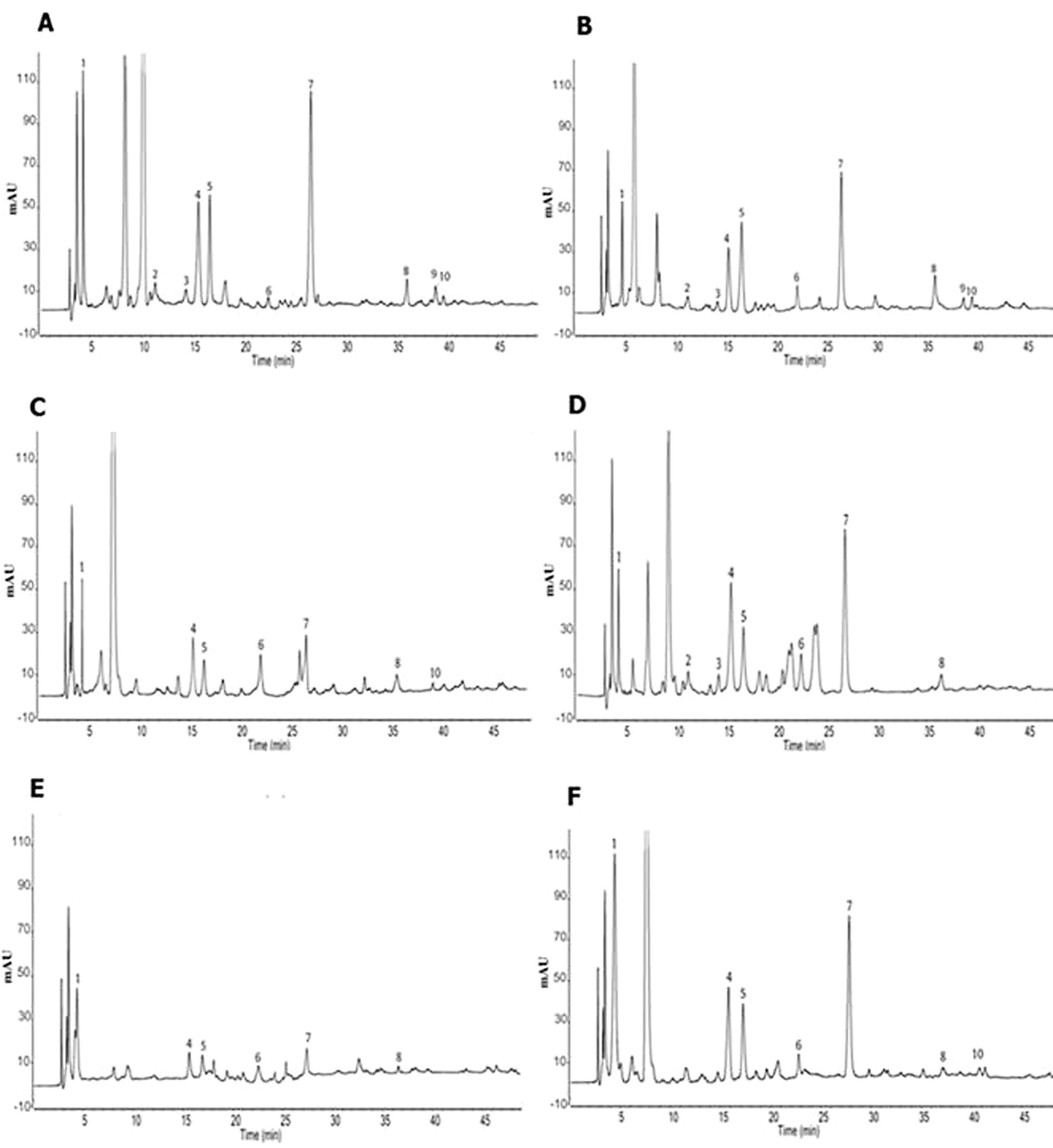
HPLC-DAD chromatograms of different date varieties. Bousrdoun (A); Jihl (B); Bousthammi (C); Majhoul (D); Bouskri (E); Boufgous (F). Peak numbers: gallic acid (1); chlorogenic acid (2); vanillic acid (3); caffeic acid (4); syringic acid (5); p-coumaric acid (6); ferulic acid (7); rutin (8); luteolin (9); quercetin (10).
Date varieties (mg/100 g DW)
Boufgous
Bouskri
Bousrdoun
Bousthammi
Jihl
Majhoul
Phenolic Acids
Caffeic acid
2.07 ± 0.14
0.92 ± 0.11
2.34 ± 0.13
1.37 ± 0.10
2.59 ± 0.16
1.62 ± 0.12
Chlorogenic acid
0.81 ± 0.06
Nd
1.26 ± 0.05
Nd
0.63 ± 0.09
0.46 ± 0.04
p-Coumaric acid
1.12 ± 0.10
0.49 ± 0.04
1.46 ± 0.07
1.08 ± 0.09
1.74 ± 0.12
0.68 ± 0.05
Ferulic acid
2.49 ± 0.14
1.28 ± 0.14
3.82 ± 0.15
1.96 ± 0.11
3.21 ± 0.17
2.74 ± 0.25
Gallic acid
10. 38 ± 0.27
7.02 ± 0.17
9.52 ± 0.23
6.27 ± 0.25
8.16 ± 0.37
5.53 ± 0.20
Syringic acid
1.34 ± 0.07
0.63 ± 0.06
1.81 ± 0.12
0.93 ± 0.09
1.57 ± 0.06
1.24 ± 0.10
Vanillic acid
0.27 ± 0.04
Nd
0.52 ± 0.03
Nd
0.35 ± 0.05
0.39 ± 0.08
Flavonoids
Luteolin
Nd
Nd
0.24 ± 0.03
Nd
0.37 ± 0.03
Nd
Quercetin
0.33 ± 0.02
Nd
0.83 ± 0.04
0.41 ± 0.07
0.69 ± 0.05
Nd
Rutin
0.94 ± 0.16
0.52 ± 0.14
2.31 ± 0.21
1.63 ± 0.15
2.86 ± 0.20
0.74 ± 0.13
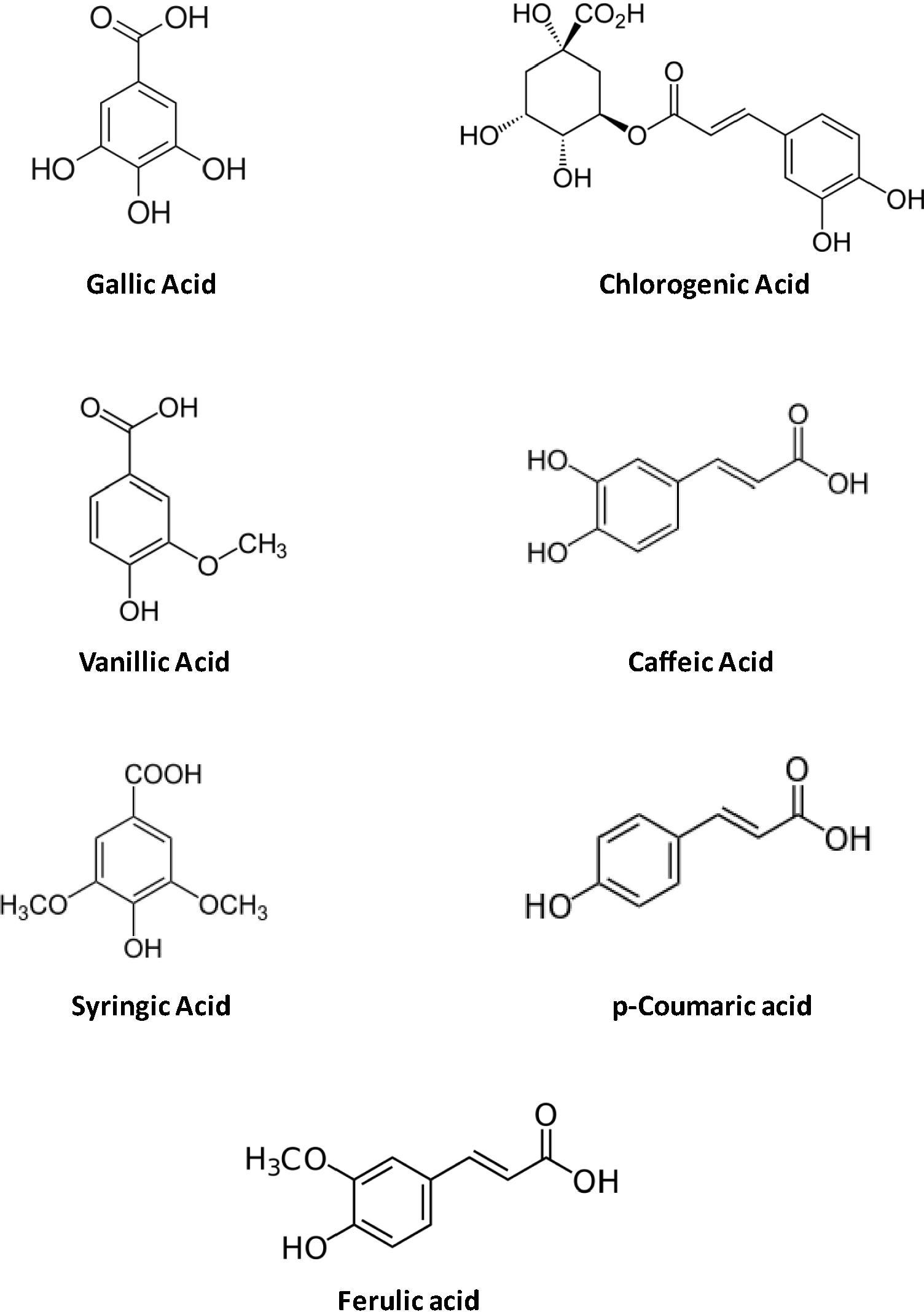
Chemical structures of the identified phenolic acids.
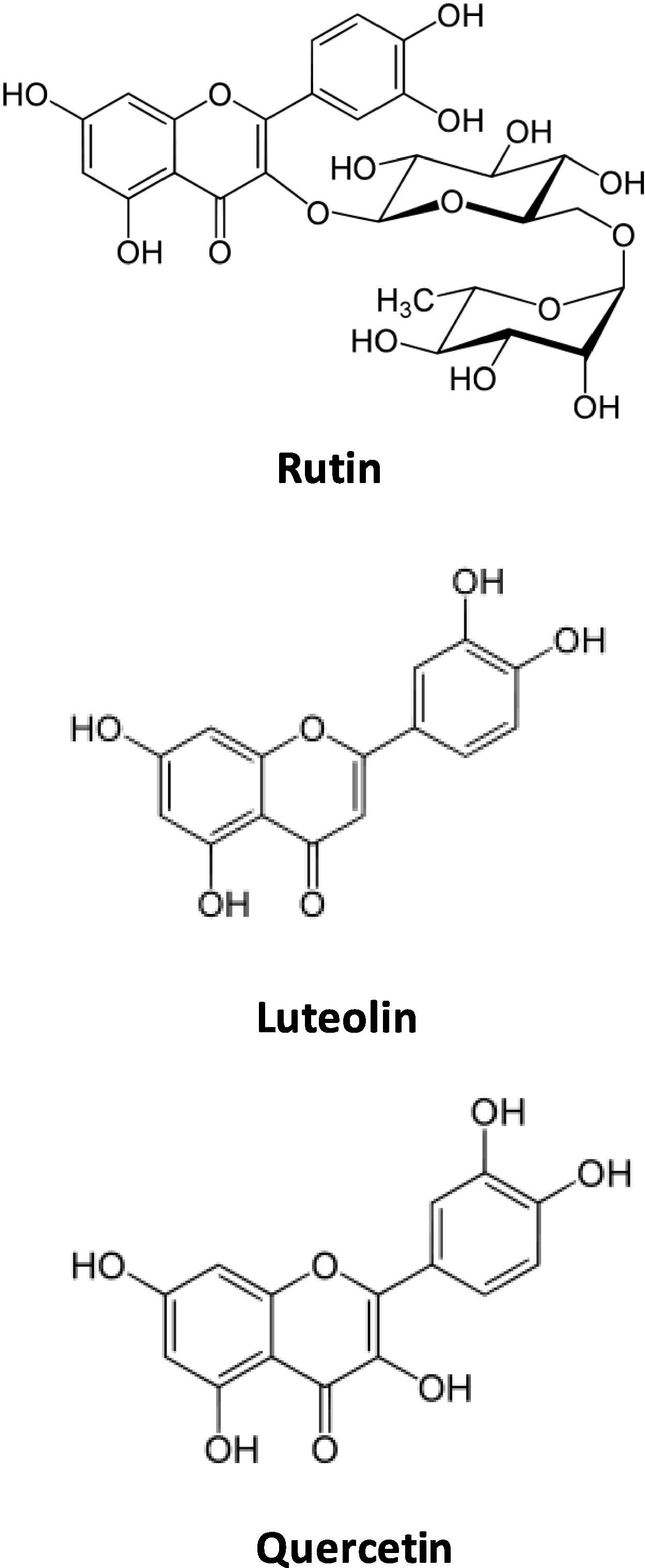
Chemical structures of the identified flavonoids.
On the other hand, among the flavonoidic compounds, Rutin was the most predominant (0.52–2.86 mg/100g followed by Quercetin, which was present in all varieties except Bouskri and Majhoul. Meanwhile, Luteolin was found only in Jihl and Bousrdoun. The differences of phenolic profile among date varieties may be attributed to many factors such as growing conditions, maturity, harvesting time, received sunlight, geographic origin, fertilizer, soil type, and storage conditions (Al Harthi et al., 2015; Bouhlali et al., 2015).
3.2 Nitric oxide radical scavenging activity
Nitric oxide (NO) is a strong mediator that is involved in neurotransmission, resistant reactions, provocative and vascular homeostasis (Tuteja et al., 2004). Moreover, an excess amount of NO is associated with several diseases such as systemic lupus, psoriasis, and septic shock (Abramson et al., 2001; Paolo, 2013). In addition, different test models of inflammation including carrageenan prompted vascular permeability in rat skin are associated with an expansion in nitric oxide generation (Kubes et al., 1991). The scavenging effect of date fruit varieties on nitric oxide production is presented in Table 2. Values in average (n = 6) ± SD. *: Indomethacin, **: Trolox.
Membrane stabilization activity (IC50) (µg/mL)
Inhibition of protein denaturation (IC50) (µg/mL)
Nitric oxide radical scavenging activity (IC50) (µg/mL)
Boufgous
689.67 ± 6.78
583.09 ± 6.59
654.93 ± 3.65
Bouskri
803.22 ± 12.06
757.28 ± 7.93
989.30 ± 4.62
Bousrdoun
483.61 ± 6.24
408.64 ± 6.94
531.34 ± 4.08
Bousthammi
753.94 ± 8.43
568.77 ± 8.87
753.79 ± 3.11
Jihl
543.28 ± 8.14
518.05 ± 6.09
701.86 ± 4.84
Majhoul
682.09 ± 6.43
611.38 ± 8.39
862.08 ± 4.36
Standard
97.83 ± 0.66*
86.07 ± 0.84*
95.04 ± 2.12**
The highest nitric oxide scavenging ability was found in Bousrdoun (IC50 = 531.34 µg/mL), but it remains lower than that of Trolox (IC50 = 95.04 µg/mL). These findings are in agreement with those reported in our previous study (Bouhlali et al., 2016b), showing a high significant scavenging activity in DPPH and ABTS assays. These significant activities could be explained by the high phenolic and flavonoidic content of date fruits.
3.3 Inhibition of albumin denaturation
Many diseases such as serum sickness, glomerulonephritis, rheumatoid arthritis and systemic lupus erythematosus are caused by a type III hypersensitive reaction (Menon et al., 2011). Furthermore, the inhibition of protein denaturation is the fundamental mechanism of NSAIDs action (Mizushima and Kobayashi, 1968) before the discovery of their inhibitory ability on cyclooxygenase by Vane (1971). Therefore, the alleged ability of different date fruits to prevent protein denaturation was assessed as part of their anti-inflammatory effect. All analyzed date fruit varieties inhibited the denaturation of bovine serum albumin in a dose dependent manner (Table 2). The potency order was as follows: Bousrdoun > Jih > Bousthammi > Boufgous > Majhoul > Bouskri. This effect variation may be related to the difference in phenolics contents between date fruit varieties.
3.4 Membrane stabilization potential
Inflammatory response resulted in a significant release of lysosomal components leading to further tissues inflammation (Lima et al., 2013). Several medicinal extracts limit this process via their membrane stabilizing properties (Mounnissamy et al., 2008). In this sense, we have investigated the ability of date fruit to stabilize the erythrocyte membrane. These cells were chosen based on the similarity between their membranes and the lysosomal ones. As shown in table 2, Bousrdoun exhibited the highest membrane stabilizing activity (IC50 = 483.61 ± 5.34 µg/mL) followed by Boufgous, Jihl, Majhoul, Bousthammi, and Bouskri. Thus, the similarity between erythrocyte and lysosomal membranes plead in favor of the ability of date fruit extracts to stabilize the lysosomal membranes as well. These results are consistent with those obtained for other medicinal plants extracts (Chopade et al., 2012). Therefore, it can be postulated that the stabilization capacity of erythrocyte membrane by date fruit extract may mediate its anti-inflammatory activity. In this context, our previous study (Bouhlali et al. 2016b), have reported a highly content in phenolics within these date varieties. Hence, these compounds may be the principal contributors to the membrane protective activity of date fruit extract.
3.5 Croton oil-induced ear edema in mice
Croton oil-induced ear edema is a usually used assay to investigate the anti-inflammatory power of natural remedies that could be beneficial to cure skin illnesses (Cabrini et al., 2011). The main irritant factor in this process is 12-O-Tetradecanoylphorbol-13-acetate (TPA) (Murakawa et al., 2006) whose action is exerted by cyclooxygenase, and other inflammatory mediators (Saraiva et al., 2011). The date fruit extracts decreased significantly (p < 0.05) ear thickness compared to the control mice. Among the analyzed date fruit varieties, Jihl exhibited the highest reduction of ear edema (74%), whereas Bouskri showed the lowest one (19.33%) (Fig. 4A). Consequently, in light of the current results, date fruit compounds could influence at least one steps of the inflammatory process induced by the croton oil. Indeed, gallic acid, ferulic acid and caffeic acid, found as the main phenolic acids in the analysed date fruit varieties, can reduce COX-2 action (Nile et al., 2016). In addition, previous studies have demonstrated that rutin possess higher inhibitory activity against COX-1, COX-2 and 15-LOX (Zhang et al. 2013b; Gautam et al. 2016; Zhang et al. 2015).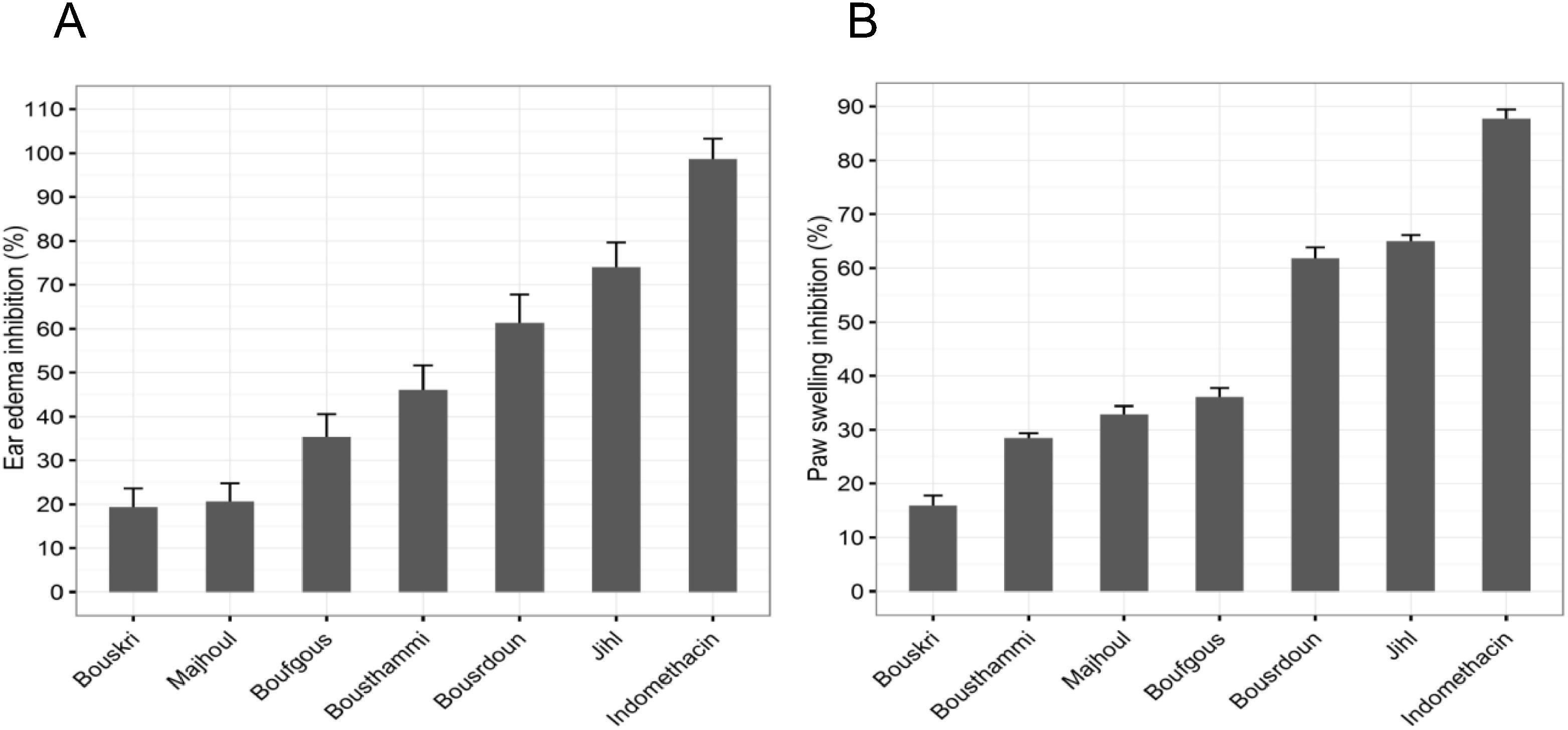
Anti-inflammatory activities of aqueous extracts of six date fruit on croton oil induced mice ear edema (A), and carrageenan induced rat paw edema (B). Animals were treated with aqueous extract of Bouskri, Bousthammi, Majhoul, Boufgous, Bousrdon, and Jihl at 2 mg/kg. Indomethacin was used as a positive control (10 mg/kg). Values are expressed as a mean ± SD, (n = 6).The anti-inflammatory activity was expressed as a percentage of the edema inhibition in the treated ear or paw in comparison to controls.
3.6 Carrageenan-induced inflammation in rat paw
To evaluate the anti-inflammatory activity of date fruit extracts, carrageenan-induced edema in rat’s right hind paw was undertaken. The highest inhibition of paw swelling was observed in Jihl (65.02%) at the 4th hour of the experiment while the untreated animals reached a maximal intensity of edema. The lowest inhibition (15.97%) of paw swelling ratio was found in Bouskri (Fig. 4). This anti-inflammatory activity is still lower than that of indomethacin. These findings are similar to those reported by Ali Haimoud et al. (2016) who found an inhibition of paw edema varying between 35.64–67.56% after 5 h of carrageenan injection. Moreover, Kehili et al. (2016) using formalin mice paw edema assays have also reported a significant anti-inflammatory activity (68.23%). Moreover, Mohamed and Al-Okbi (2004) have noted that oral administration of date fruits extracts suppresses the foot swelling induced by adjuvant arthritis. The significant (p < 0.01) inhibition of paw edema by date fruit extracts, from the early stages of inflammation (Fig. 5A-F), is likely due to an inhibition of chemical mediators of inflammation. It is well stated in the literature that some polyphenolic compounds like caffeic acid and quercetin decrease the levels of nuclear factor–κB, which ultimately inhibits the production of NO via the reduction of iNOS biosynthesis (Kassim et al., 2010). Correspondingly, gallic acid has also been shown to inhibit secretion of histamine and pro-inflammatory cytokines from human activated mast cells (Kim et al., 2006). In addition, ferulic acid has been reported to reduce the activity of superoxide dismutase (SOD), myeloperoxidase (MPO), nitric oxide (NO), and prostaglandin E2 levels during acetic acid induced-inflammation in rats (Dong et al., 2003). Of note, the synergic effect of the phenolic compounds identified in the date fruits cannot be excluded in these experiments.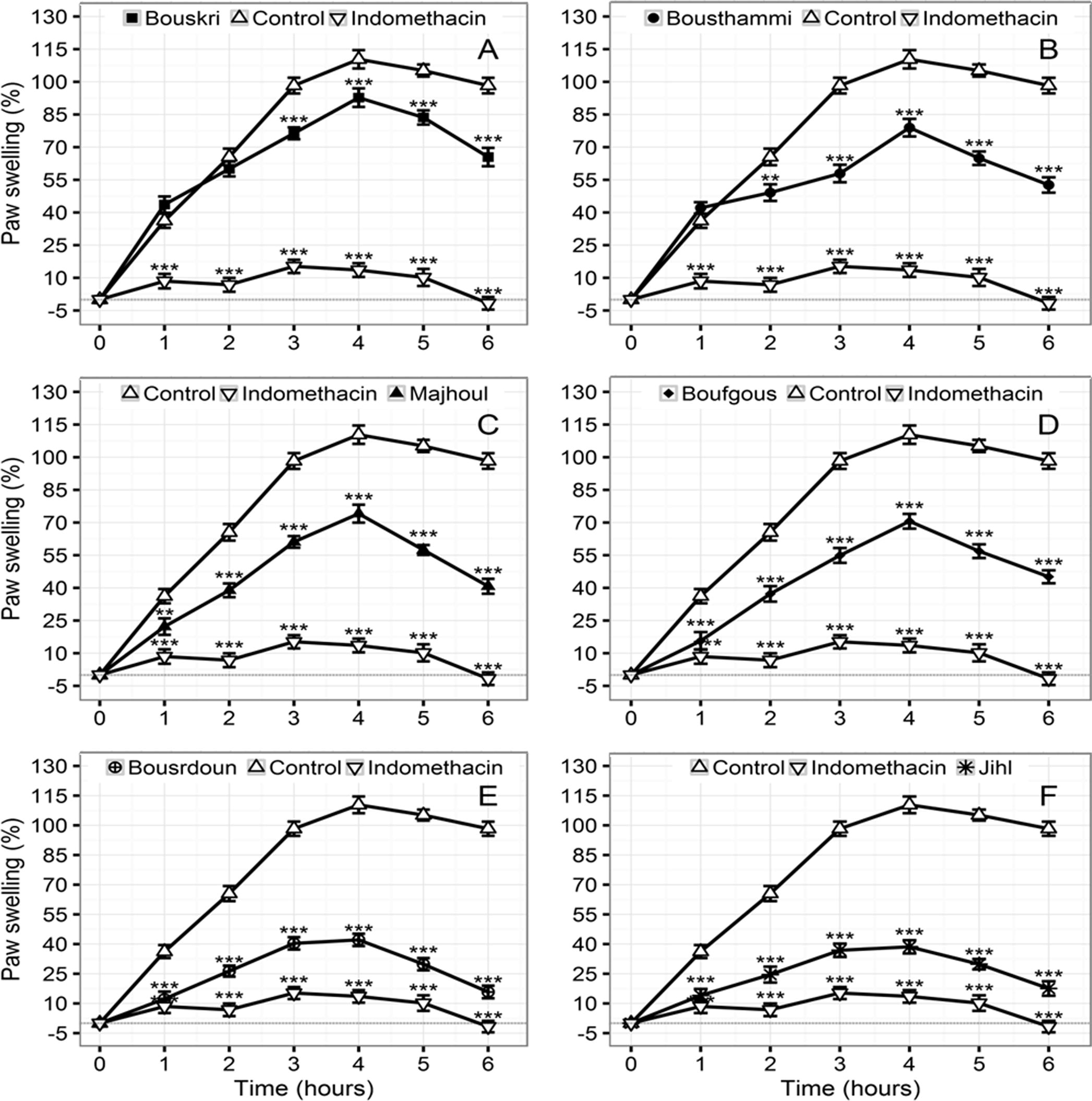
Evolution of edema formation in rat paws. The animals (n = 6) were treated with aqueous extract of six date fruit varieties at 2 g/kg: Indomethacin was used as a positive control (10 mg/kg), Bouskri (A), Bousthammi (B), Majhoul (C), Boufgous (D), Bousrdon (E), Jihl (F). Data obtained from animal experiments were expressed as mean ± SD. ** P < 0.01; *** P < 0.001.
4 Conclusion
In conclusion, among the six Moroccan date varieties, Bousrdoun and Jihl showed the most significant NO scavenging, membrane stabilisation, protein denaturation, and edema inhibition activity. This sustains the ethnopharmacological use of Phoenix dactylifera fruits as anti-inflammatory agents. Polyphenols are the predominant compounds of date extracts, which makes them potential candidates in these activities. Further studies are in progress to elucidate the active constituent in hope to understand their effects better.
References
- Protective effect of dates (Phoenix dactylifera L.) and licorice (Glycyrrhiza glabra) on carbon tetrachloride induced hepatotoxicity in dogs. Global Veterinaria. 2012;9(2):184-191.
- [Google Scholar]
- The role of nitric oxide in tissue destruction. Best Pract. Res. Clin. Rheumatol.. 2001;15(5):831-845.
- [Google Scholar]
- Quantification of phenolic compounds, evaluation of physicochemical properties and antioxidant activity of four date (Phoenix dactylifera L.) varieties of Oman. J. Taibah Univ. Med. Sci.. 2015;10(3):346-352.
- [Google Scholar]
- Antioxidant and anti-inflammatory properties of widely consumed date palm (Phoenix Dactylifera L.) fruit varieties in algerian oases. J. Food Biochem.. 2016;40(4):463-471.
- [Google Scholar]
- Effects of the ripening stage on phenolic profile, phytochemical composition and antioxidant activity of date palm fruit. J. Agric. Food Chem.. 2012;60(44):10896-10902.
- [Google Scholar]
- The evaluation of nitric oxide scavenging activity of Acalypha indica Linn root. Asian J. Res. Chem. (AJRC). 2009;2(2):148-150.
- [Google Scholar]
- Phenolic composition and antioxidant capacities of ten Algerian date (Phoenix dactylifera L.) cultivars: a comparative study. J. Funct. Foods. 2013;5(1):346-354.
- [Google Scholar]
- Antioxidant and anti-hemolytic activities of phenolic constituents of six moroccan date fruit (Phoenix dactylifera L.) syrups. Biotechnol. Indian J.. 2016;12(1):45-52.
- [Google Scholar]
- Phytochemical compositions and antioxidant capacity of three date (Phoenix dactylifera L.) seeds varieties grown in the South East Morocco. J. Saudi Soc. Agric. Sci. 2015
- [Google Scholar]
- Evaluation of antioxidant, antihemolytic and antibacterial potential of six Moroccan date fruit (Phoenix dactylifera L.) varieties. J. King Saud Univ.-Sci.. 2016;28(2):136-142.
- [Google Scholar]
- Analysis of the potential topical anti-inflammatory activity of Averrhoa carambola L. in mice. Evid.-Based Complement. Alternat. Med. 2011
- [Google Scholar]
- The date palm (Phoenix dactylifera L.): overview of biology, uses, and cultivation. HortScience. 2007;42(5):1077-1082.
- [Google Scholar]
- Evaluation of in vitro anti-inflammatory activity of coffee against the denaturation of protein. Asian Pac. J. Trop. Biomed.. 2012;2(1):S178-S180.
- [Google Scholar]
- Membrane stabilizing activity and protein denaturation: a possible mechanism of action for the anti-inflammatory activity of phyllanthus amarus. J. Karad. Inst. Med. Sci. Univ.. 2012;1(1):67-72.
- [Google Scholar]
- Ameliorative effects of sodium ferulate on experimental colitis and their mechanisms in rats. World J. Gastroenterol.. 2003;9(11):2533-2538.
- [Google Scholar]
- Effect of cultivar type and ripening on the polyphenol content of date palm fruit. J. Agric. Food Chem.. 2013;61(10):2453-2460.
- [Google Scholar]
- Aqueous date fruit extract protects against lipid peroxidation and improves antioxidant status in the liver of rats subchronically exposed to trichloroacetic acid. J. Physiol. Biochem.. 2014;70(2):451-464.
- [Google Scholar]
- Gautam, R., Singh, M., Gautam, S., Rawat, J.K., Saraf, S.A., Kaithwas, G., 2016. Rutin attenuates intestinal toxicity induced by Methotrexate linked with anti-oxidative and anti-inflammatory effects. BMC Complement Altern. Med. 2016 Mar 10;16:99.
- Metabolic analysis of various date palm fruit (Phoenix dactylifera L.) cultivars from Saudi Arabia to assess their nutritional quality. Molecules. 2015;20(8):13620-13641.
- [Google Scholar]
- Jain S.M., Priyadarshan P.M., eds. Breeding Plantation Tree Crops: Tropical Species. Springer; 2009. p. :3-50.
- Ellagic acid, phenolic acids, and flavonoids in Malaysian honey extracts demonstrate in vitro anti-inflammatory activity. Nutr. Res.. 2010;30(9):650-659.
- [Google Scholar]
- Anti-inflammatory effect of Algerian date fruit (Phoenix dactylifera) Food Agric. Immunol.. 2016;27(6):820-829.
- [Google Scholar]
- Anti-inflammatory, anticoagulant and antioxidant effects of aqueous extracts from Moroccan thyme varieties. Asian Pac. J. Trop. Biomed.. 2015;5(8):636-644.
- [Google Scholar]
- Gallic acid inhibits histamine release and pro-inflammatory cytokine production in mast cells. Toxicol. Sci.. 2006;91(1):123-131.
- [Google Scholar]
- Nitric oxide: an endogenous modulator of leukocyte adhesion. Proc. Natl. Acad. Sci.. 1991;88(11):4651-4655.
- [Google Scholar]
- Role of lysosome rupture in controlling Nlrp3 signaling and necrotic cell death. Cell Cycle. 2013;12
- [Google Scholar]
- Anti-inflammatory and cytotoxic activity of methanolic extract of Plectranthus hadiensis stem. Pharmacologyonline. 2011;3:275-282.
- [Google Scholar]
- The effects of plant flavonoids on mammalian cells: implications for inflammation, heart disease, and cancer. Pharmacol. Rev.. 2000;52(4):673-751.
- [Google Scholar]
- Interaction of anti-inflammatory drugs with serum proteins, especially with some biologically active proteins. J. Pharm. Pharmacol.. 1968;20(3):169-173.
- [Google Scholar]
- Evaluation of Anti-inflammatory and Membrane stabilizing property of Ethanol Extract of Cansjera rheedii J. Gmelin (Opiliaceae) Iran. J. Pharmacol. Ther.. 2008;6(2):235-237.
- [Google Scholar]
- In vivo evaluation of antioxidant and anti-inflammatory activity of different extracts of date fruits in adjuvant arthritis. Pol. J. Food Nutr. Sci.. 2004;13(54):397-402.
- [Google Scholar]
- Comparative evaluation of different extraction methods for antioxidant and anti-inflammatory properties from Osbeckia parvifolia Arn.-An in vitro approach. J. King Saud Univ.-Sci.. 2014;26(4):267-275.
- [Google Scholar]
- Involvement of tumor necrosis factor (TNF)-alpha in phorbol ester 12-O-tetradecanoylphorbol-13-acetate (TPA)-induced skin edema in mice. Biochem. Pharmacol.. 2006;71:1331-1336.
- [Google Scholar]
- Sensory and textural changes in maturing Omani dates. J. Sci. Food Agric.. 2000;80(15):2181-2185.
- [Google Scholar]
- Screening of ferulic acid related compounds as inhibitors of xanthine oxidase and cyclooxygenase-2 with anti-inflammatory activity. Revista Brasileira de Farmacognosia.. 2016;26(1):50-55.
- [Google Scholar]
- Paolo, S., 2013. Nitric Oxide in Human Health and Disease. eLS.
- Topical anti-inflammatory effect of Caryocar coriaceum Wittm. (Caryocaraceae) fruit pulp fixed oil on mice ear edema induced by different irritant agents. J. Ethnopharmacol.. 2011;136:504-510.
- [Google Scholar]
- Ethnopharmacological survey of plants used in the traditional treatment of hypertension and diabetes in south-eastern Morocco (Errachidia province) J. Ethnopharmacol.. 2007;110(1):105-117.
- [Google Scholar]
- Nitric oxide as a unique bioactive signaling messenger in physiology and pathophysiology. BioMed Res. Int.. 2004;2004(4):227-237.
- [Google Scholar]
- Inhibition of prostaglandin synthesis as a mechanism of action for aspirin-like drugs. Nature. 1971;231(25):232-235.
- [Google Scholar]
- Carrageenin-induced edema in hind paw of the rat as an assay for antiinflammatory drugs. Exp. Biol. Med.. 1962;111(3):544-547.
- [Google Scholar]
- Simultaneous determination of 14 phenolic compounds in grape canes by HPLC-DAD-UV using wavelength switching detection. Molecules. 2013;18(11):14241-14257.
- [Google Scholar]
- Antioxidant and anti-inflammatory assays confirm bioactive compounds in Ajwa date fruit. J. Agric. Food Chem.. 2013;61(24):5834-5840.
- [Google Scholar]
- Health-benefits of date fruits produced in Saudi Arabia based on in vitro antioxidant, anti-inflammatory and human tumor cell proliferation inhibitory assays. J. Saudi Soc. Agric. Sci. 2015
- [Google Scholar]
- Ethical guidelines for investigations of experimental pain in conscious animals. Pain. 1983;16(2):109-110.
- [Google Scholar]







